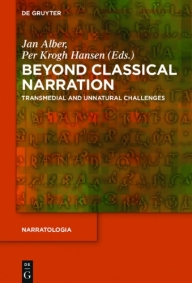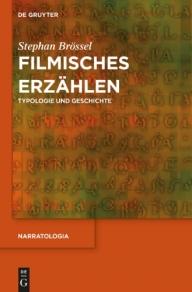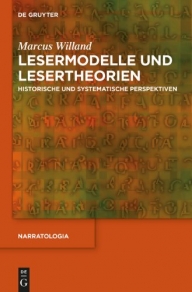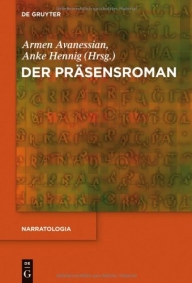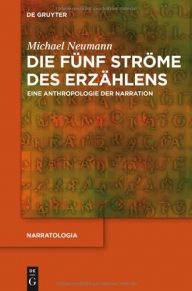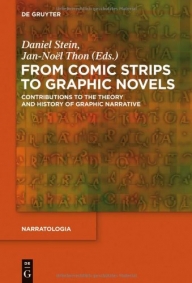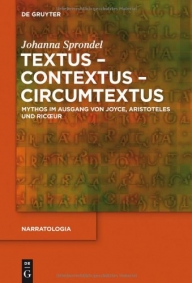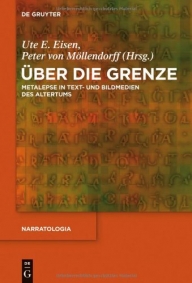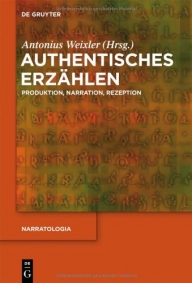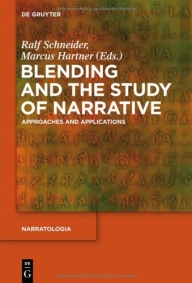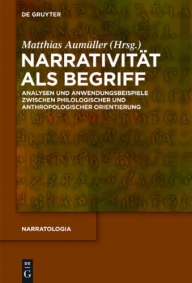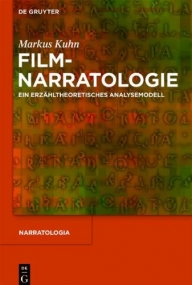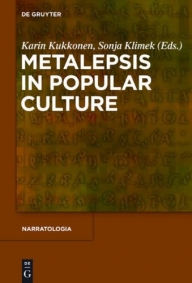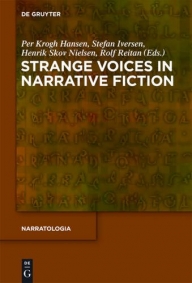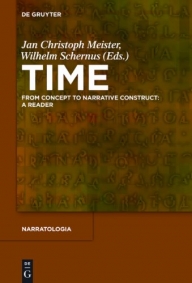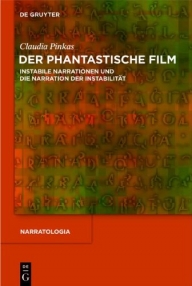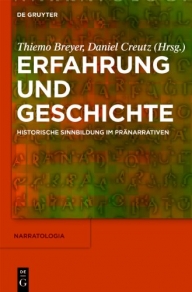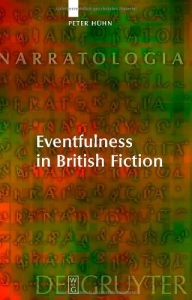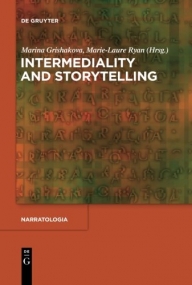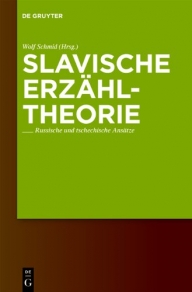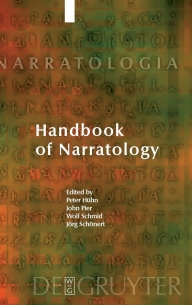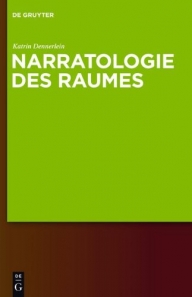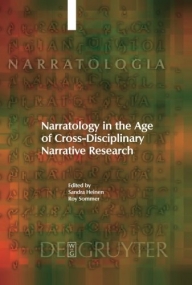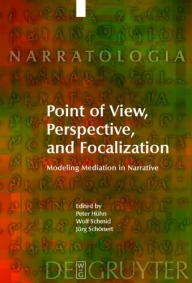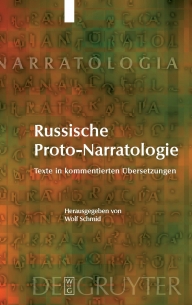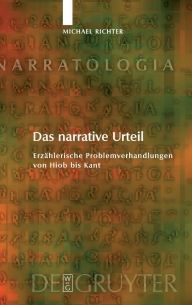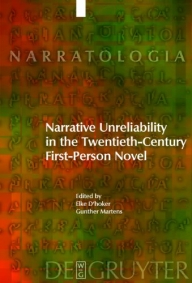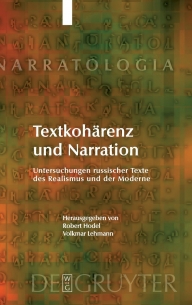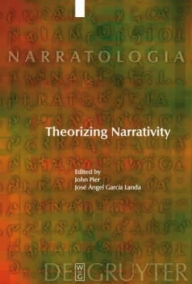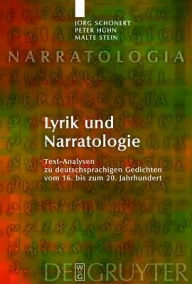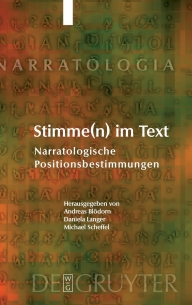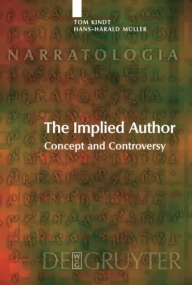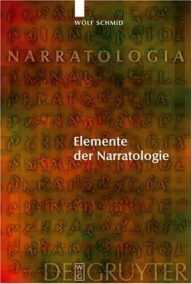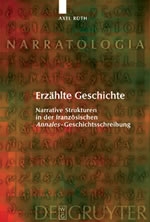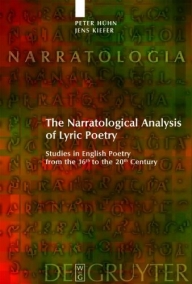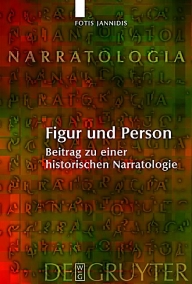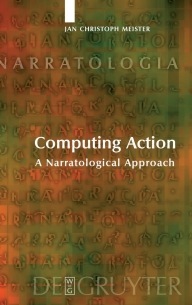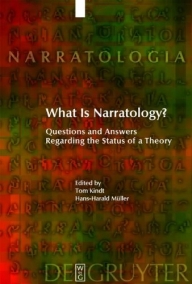2014
Jan Alber, Per Krogh Hansen
Beyond Classical Narration. Transmedial and Unnatural Challenges
Alber, Jan & Per Krogh Hansen (eds.): Beyond Classical Narration. Transmedial and Unnatural Challenges. Berlin/New York: de Gruyter 2014 (Narratologia 42).
This collection of essays looks at two important manifestations of postclassical narratology, namely transmedial narratology on the one hand, and unnatural narratology on the other. The articles deal with films, graphic novels, computer games, web series, the performing arts, journalism, reality games, music, musicals, and the representation of impossibilities. The essays demonstrate how new media and genres as well as unnatural narratives challenge classical forms of narration in ways that call for the development of analytical tools and modelling systems that move beyond classical structuralist narratology. The articles thus contribute to the further development of both transmedial and unnatural narrative theory, two of the most important manifestations of postclassical narratology.
Filmisches Erzählen. Typologie und Geschichte
[Cinematic Narrative: Typology and history]
Brössel, Stephan: Filmisches Erzählen. Typologie und Geschichte. Berlin/New York: de Gruyter 2014 (Narratologia 40).
Cinematic structures in literature have generally been examined from the perspective of intermediality theory, thereby neglecting some particular features of cinematic narrative. The author develops an analytic model based on narratology and sensitivity to context, offering insights into the typological spectrum of cinematic narrative and its history from the 19th century until the present day.
Lesermodelle und Lesertheorien. Historische und systematische Perspektiven
[The Reader in Literary Theory: Historical and Systematic Perspectives]
Willand, Marcus: Lesermodelle und Lesertheorien. Historische und systematische Perspektiven. Berlin/New York: de Gruyter 2014 (Narratologia 41).
Literaturwissenschaftliche Theorie und Praxis ist von einer bislang kaum wahrgenommenen Asymmetrie gekennzeichnet: demKontrast zwischen den intensiven Bemühungen, Rezeptionsforschung und -theorie als Disziplin wissenschaftlich zu fundieren, und den unzulänglichenVersuchen, die aus diesen Positionen hervorgehenden Lesermodelle systematisch zu erfassen. Eine solche Systematisierung steht im Zentrum dieser wissenschaftstheoretischen Arbeit.
Ein ähnliches Ungleichgewicht besteht zwischen dem großen Aufwand, mit dem Editionsphilologien eine standardisierte Sicherung von Primärtexten als Vorbereitung der Textinterpretation betreiben, und der limitierten Aufmerksamkeit, die dabei historischen Rezeptionstexten eingeräumt wird. Während der erste Teil der Arbeit Lesermodelle systematisiert und hinsichtlich ihrer Funktionalisierbarkeit für eine historisierende Literaturwissenschaft prüft, formuliert der zweite Teil eine theoretische Begründung und einen methodischen Entwurf der historisierenden Rezeptionsanalyse. Sie sichtet und sichert Rezeptionszeugnisse realer Leser zur Stützung der interpretativ-hermeneutischen, sozialhistorischen und im weitesten Sinne empirischen Argumentation literaturwissenschaftlicher Historisierung.
The Experientiality of Narrative. An Enactivist Approach
Caracciolo, Marco: The Experientiality of Narrative. An Enactivist Approach. Berlin/New York: de Gruyter 2014 (Narratologia 43).
Recent developments in cognitive narrative theory have called attention to readers' active participation in making sense of narrative. However, while most psychologically inspired models address interpreters' subpersonal (i.e., unconscious) responses, the experiential level of their engagement with narrative remains relatively undertheorized. Building on theories of experience and embodiment within today's "second-generation" cognitive science, and opening a dialogue with so-called "enactivist" philosophy, this book sets out to explore how narrative experiences arise from the interaction between textual cues and readers' past experiences. Caracciolo's study offers a phenomenologically inspired account of narrative, spanning a wide gamut of responses such as the embodied dynamic of imagining a fictional world, empathetic perspective-taking in relating to characters, and "higher-order" evaluations and interpretations. Only by placing a premium on how such modes of engagement are intertwined in experience, Caracciolo argues, can we do justice to narrative's psychological and existential impact on our lives. These insights are illustrated through close readings of literary texts ranging from Émile Zola's Germinal to José Saramago's Blindness.
2013
Armen Avanessian, Anke Hennig
Der Präsensroman
[The Present Tense in the 20th Century Novel]
Avanessian, Armen & Anke Hennig (eds.): Der Präsensroman. Berlin/New York: de Gruyter 2013 (Narratologia 36).
This minutely detailed examination of a supposedly small grammatical detail, the use of the present tense, opens up new perspectives on a founding myth of the aesthetics of modernity: the longing for presence. This collection approaches the issue by documenting how the present tense became dominant in the 20th century novel. The authors draw on perspectives in fiction theory and narratology to delineate facets of this fundamental shift in literary aesthetics from the past tense to the present.
Die fünf Ströme des Erzählens. Eine Anthropologie der Narration
[The Five Streams of Narrative: An Anthropology of Narration]
Neumann, Michael: Die fünf Ströme des Erzählens. Eine Anthropologie der Narration. Berlin/New York: de Gruyter 2013 (Narratologia 35).
Storytelling is an essential element of human nature. This study identifies five universal "streams of narrative" – that is, five "hyper-genres" that serve as a system for classifying virtually all kinds of narration. In conjunction with concepts drawn from biology, psychology, and sociology, the study develops a solid anthropological foundation for these five streams of narrative. The author uses examples from diverse cultures, eras, and media to demonstrate the occurrence of overlapping and blending between the streams.
From Comic Strips to Graphic Novels. Contributions to the Theory and History of Graphic Narrative
Stein, Daniel & Jan-Noël Thon (eds.): From Comic Strips to Graphic Novels. Contributions to the Theory and History of Graphic Narrative. Berlin/New York: de Gruyter 2013 (Narratologia 37).
- combines narratological analysis with historical exploration of graphic narrative
- investigates the development of narrative styles across genres
- covers graphic narrative beyond single national traditions
This essay collection examines the theory and history of graphic narrative – realized in various different formats, including comic strips, comic books, and graphic novels – as one of the most interesting and versatile forms of storytelling in contemporary media culture. The contributions assembled in this volume test the applicability of narratological concepts to graphic narrative, examine aspects of graphic narrative beyond the ‘single work,’ consider the development of particular narrative strategies within individual genres, and trace the forms and functions of graphic narrative across cultures. Analyzing a wide range of texts, genres, and narrative strategies from both theoretical and historical perspectives, the international group of scholars gathered here offers state-of-the-art research on graphic narrative in the context of an increasingly postclassical and transmedial narratology.
Textus – Contextus – Circumtextus. Mythos im Ausgang von Joyce, Aristoteles und Ricoeur
[Text, Context, and Circumtext: Myth in Relation to Joyce, Aristotle, and Ricoeur]
Sprondel, Johanna: Textus – Contextus – Circumtextus. Mythos im Ausgang von Joyce, Aristoteles und Ricoeur. Berlin/New York: de Gruyter 2013 (Narratologia 38).
This work uses textual hermeneutics to examine how we might conceive of myth as method. Following the central thesis that myth is uniquely suited for depicting cultural, historical, and social change, this book analyzes the topic through the examples of James Joyce’s Ulysses, Aristotelian poetics, and the late writings of Paul Ricœur. This interdisciplinary study makes a literary and philosophical contribution to elucidating the question of what we narrate when we are narrating myths.
Ute E. Eisen, Peter von Möllendorff
Über die Grenze. Metalepse in Text- und Bildmedien des Altertums
[Transferring Borders. Metalepsis in Texts and Artifacts of Antiquity]
Eisen, Ute E. & Peter von Möllendorff (eds.): Über die Grenze. Metalepse in Text- und Bildmedien des Altertums. Berlin/New York: de Gruyter 2013 (Narratologia 39).
There has been little previous research in ancient studies on the narratological notion of metalepses. The essays in this volume describe the forms, functions, and effects of metalepses in texts and artifacts. The authors demonstrate the diversity and ubiquity of metalepses as they occur in Akkadian and Egyptian literature, in the Hebrew Bible, in rabbinical Midrashim, in ancient pagan literature of all periods, and in early Christian literature.
2012
Authentisches Erzählen. Produktion, Narration, Rezeption
[Authentic Narrative: Production, Narration, Reception]
Weixler, Antonius (ed.): Authentisches Erzählen. Produktion, Narration, Rezeption. Berlin/New York: de Gruyter 2012 (Narratologia 33).
A central feature of the newer forms of authenticity is that they replace the truth of what is presented with the truthfulness of the presentation. While academic discussion of authenticity has focused mainly on the aesthetic aspects, this volume focuses on the narrative dimension of the phenomenon. The authors thereby reveal a conceptual shift from referential to relational authenticity. The essays examine issues related to production, narration, and reception, and thus provide the first contribution from narrative theory to research on authenticity.
Ralf Schneider, Marcus Hartner
Blending and the Study of Narrative. Approaches and Applications
Schneider, Ralf & Marcus Hartner (eds.): Blending and the Study of Narrative. Approaches and Applications. Berlin/New York: de Gruyter 2012 (Narratologia 34).
The theory of Blending, or Conceptual Integration, proposed by Gilles Fauconnier and Marc Turner, is one of most promising cognitive theories of meaning production. It has been successfully applied to the analysis of poetic discourse and micro-textual elements, such as metaphor. Prose narrative has so far received significantly less attention. The present volume aims to remedy this situation.
Following an introductory discussion of the connections between narrative and the processes of blending, the contributions demonstrate the range of applications of the theory to the study of narrative. They cover issues such as time and space, literary character and perspective, genre, story levels, and fictional minds; some chapters show how such phenomena as metalepsis, counterfactual narration, intermediality, extended metaphors, and suspense can be fruitfully studied from the vantage point of Conceptual Integration. Working within a theoretical framework situated at the intersection of narratology and the cognitive sciences, the book provides both fresh readings for individual literary and film narratives and new impulses for post-classical narratology.
Narrativität als Begriff. Analysen und Anwendungsbeispiele zwischen philologischer und anthropologischer Orientierung
[Narrativity as a Concept]
Aumüller, Matthias (ed.): Narrativität als Begriff. Analysen und Anwendungsbeispiele zwischen philologischer und anthropologischer Orientierung. Berlin/New York: de Gruyter 2012 (Narratologia 31).
The term ‘narrativity’ has gained considerable currency. But what does it actually mean? This is the question considered in the articles by linguists, media scholars, psychologists and other specialist academics that are compiled in this volume. They reveal the diversity of ways in which this term is used and describe various methods of delineation. The results indicate that narrativity is an umbrella term with a content that ranges from a philological (structure related) orientation to an anthropological (interpretation related) orientation.
Perspektivische Interaktion im Roman. Kognition, Rezeption, Interpretation
[Interacting Perspectives in the Novel: Cognition, Reception, Interpretation]
Hartner, Marcus: Perspektivische Interaktion im Roman. Kognition, Rezeption, Interpretation. Berlin/New York: de Gruyter 2012 (Narratologia 32).
How do we internalize literary characters and their fictional consciousness when we are reading? How does multi-perspectivity function? Drawing on modern cognitive research, this study addresses how the perspectives of different characters interact, and demonstrates that this interaction plays a critical role in our understanding and interpretation of literary texts. Using the English novel as an example, the author develops a general theory of perspectival interaction and demonstrates its explanatory power through detailed illustrative analyses.
2011
Current Trends in Narratology
Olson, Greta (ed.): Current Trends in Narratology. Berlin/New York: de Gruyter 2011 (Narratologia 27).
Current Trends in Narratology offers an overview of cutting-edge approaches to theories of storytelling. The introduction details how new emphases on cognitive processing, non-prose and multimedia narratives, and interdisciplinary approaches to narratology have altered how narration, narrative, and narrativity are understood. The volume also introduces a third post-classical direction of research ? comparative narratology ? and describes how developments in Germany, Israel, and France may be compared with Anglophone research. Leading international scholars including Monika Fludernik, Richard Gerrig, Ansgar Nünning, John Pier, Brian Richardson, Alan Palmer, and Werner Wolf describe not only their newest research but also how this work dovetails with larger narratological developments.
Filmnarratologie. Ein erzähltheoretisches Analysemodell
[Film Narratology. An Analysis Model of Narrative Theory]
Kuhn, Markus: Filmnarratologie. Ein erzähltheoretisches Analysemodell. Berlin/New York: de Gruyter 2011 (Narratologia 26).
Tales are told everywhere, not only in literature. Also other media, especially film, increasingly come into the focus of narrative theory. With his film narratology, Markus Kuhn provides the hitherto most comprehensive approach to the narrative analysis of the feature film and presents for the first time a systematic and theoretically coherent model of narratological film analysis. The practical and scholarly use lies both in the concise appraisal of the research situation as well as in the development of an application-oriented analysis model, which is illustrated by numerous examples of film.
Karin Kukkonen, Sonja Klimek
Metalepsis in Popular Culture
Kukkonen, Karin & Sonja Klimek (eds.): Metalepsis in Popular Culture. Berlin/New York: de Gruyter 2011 (Narratologia 28).
When readers become victims of the murder mysteries they are immersed in, when superheroes embark on a quest to challenge their authors or when the fictional rock band Gorillaz flirt with Madonna during their performance, then metalepsis in popular culture occurs. Metalepsis describes the transgression of the boundary between the fictional world and (a representation of) the real world. This volume establishes a transmedial definition of metalepsis and explores the phenomenon in twelve case studies across media and genres of popular culture: from film, TV series, animated cartoons, graphic novels and popular fiction to pop music, music videos, holographic projections and fan cultures. Narrative studies have considered metalepsis so far largely as a phenomenon of postmodern or avant-garde literature. Metalepsis in Popular Culture investigates metalepsis’ ties to the popular and traces its transmedial importance through a wealth of examples from the turn of the 20th century to this day. The articles also address larger issues such as readerly immersion, the appeal of complexity in popular culture, or the negotiation of fiction and reality in media, and invite readers to rethink these issues through the prism of metalepsis.
Per Krogh Hansen, Stefan Iversen, Henrik Skov Nielsen, Rolf Reitan
Strange Voices in Narrative Fiction
Hansen, Per Krogh, Stefan Iversen, Henrik Skov Nielsen & Rolf Reitan (eds.): Strange Voices in Narrative Fiction. Berlin/New York: de Gruyter 2011 (Narratologia 30).
From its beginnings narratology has incorporated a communicative model of literary narratives, considering these as simulations of natural, oral acts of communication. This approach, however, has had some problems with accounting for the strangeness and anomalies of modern and postmodern narratives. As many skeptics have shown, not even classical realism conforms to the standard set by oral or ‘natural’ storytelling. Thus, an urge to confront narratology with the difficult task of reconsidering a most basic premise in its theoretical and analytical endeavors has, for some time, been undeniable. During the 2000s, Nordic narratologists have been among the most active and insistent critics of the communicative model. They share a marked skepticism towards the idea of using ‘natural’ narratives as a model for understanding and interpreting all kinds of narratives, and for all of them, the distinction of fiction is of vital importance. This anthology presents a collection of new articles that deal with strange narratives, narratives of the strange, or, more generally, with the strangeness of fiction, and even with some strange aspects of narratology.
Jan Christoph Meister, Wilhelm Schernus
Time. From Concept to Narrative Construct: A Reader
Meister, Jan Christoph & Wilhelm Schernus (eds.): Time. From Concept to Narrative Construct: A Reader. Berlin/New York: de Gruyter 2011 (Narratologia 29).
The present volume is targeted at an interdisciplinary audience, i.e. partly at literary scholars/narratologists interested in time theory outside their field, and partly at scholars outside literary studies who in turn would like to learn more about such concepts created in narrative theory. The anthology assembles both English-speaking and German contributions to a narrative theory of time constructs which have thus far not been translated into English, but have– directly or indirectly– inspired the theoretical discourse across disciplines. The common methodological focus of the articles assembled here concerns the way in which the experience of chronological structure and ordering in (experienced or imagined) phenomena can be traced back to a logic of time “constructs”. Narrative time constructs– that is: models of chronological ordering which we generate while processing narratively encoded information– constitute a particularly rich body of examples. How we experience time is directly linked to how we narrate information, and how we re-construct principles of temporal ordering in the narrated content.The logic of narrative time constructs has therefore been of interest not only to narrative theory, but also to philosophy and cognitive science, and more recently to computational approaches toward modelling human time experience.
2010
Der phantastische Film. Instabile Narrationen und die Narration der Instabilität
[Fantastic Narration in Film. Instable Narrations and Narration of Instability]
Pinkas, Claudia: Der phantastische Film. Instabile Narrationen und die Narration der Instabilität. Berlin/New York: de Gruyter 2010 (Narratologia 25).
This book investigates the narrated worlds of fantastic film and the methods of their narrative mediation. This includes instable and ambiguous perspectives of perception, abandonment and disintegration of spatial-temporal continuity, instances of destabilized narrators, blending of the narrative levels as well as categories of figure, space and the event of crossing borders of the genre in the staging of virtual media realities in the fantastic film. The book refers to examples of the early years of fictional film up to the present.
Thiemo Breyer, Daniel Creutz
Erfahrung und Geschichte. Historische Sinnbildung im Pränarrativen
[Experience and History. Historical Creation of Meaning in the Pre-narrative Context]
Breyer, Thiemo & Daniel Creutz (eds.): Erfahrung und Geschichte. Historische Sinnbildung im Pränarrativen. Berlin/New York: de Gruyter 2010 (Narratologia 23).
In the interdisciplinary discourse between philosophy and historical, literary, and cultural studies this book explores the relationship between historical narratives and the experiences on which they are based and which give the first impetus for a genuine need to tell the story. Here a new concept of historical experience is formulated which elucidates the pre-narrative dimensions of historical creation of meaning and thus also enables a more adequate determination of the relationship of history and narration as well as individual and collective history.
Markus Kempf, Katrin Kroll, Jette K. Wulf
Eventfulness in British Fiction
Hühn, Peter (u.a.): Eventfulness in British Fiction. Berlin/New York: de Gruyter 2010 (Narratologia 18).
An event, defined as the decisive turn, the surprising point in the plot of a narrative, constitutes its tellability, the motivation for reading it. This book describes a framework for a narratological definition of eventfulness and its dependence on the historical, socio-cultural and literary context. A series of fifteen analyses of British novels and tales, from late medieval and early modern times to the late 20th century, demonstrates how this concept can be put into practice for a new, specifically contextual interpretation of the central relevance of these texts. The examples include Chaucer’s “Miller’s Tale”, Behn’s “Oroonoko”, Defoe’s “Moll Flanders”, Richardson’s “Pamela”, Fielding’s “Tom Jones”, Dickens’s “Great Expectations”, Hardy's “On the Western Circuit”, James’s “The Beast in the Jungle”, Joyce’s “Grace”, Conrad’s “Shadow-Line”, Woolf’s “Unwritten Novel”, Lawrence’s “Fanny and Annie”, Mansfield’s “At the Bay”, Fowles’s “Enigma” and Swift’s “Last Orders”. This selection is focused on the transitional period from 19th-century realism to 20th-century modernism because during these decades traditional concepts of what counts as an event were variously problematized; therefore, these texts provide a particularly interesting field for testing the analytical capacity of the term of eventfulness.
Marina Grishakova, Marie-Laure Ryan
Intermediality and Storytelling
Grishakova, Marina & Marie-Laure Ryan (eds.): Intermediality and Storytelling. Berlin/New York: de Gruyter 2010 (Narratologia 24).
The ‘narrative turn’ in the humanities, which expanded the study of narrative to various disciplines, has found a correlate in the ‘medial turn’ in narratology. Long restricted to language-based literary fiction, narratology has found new life in the recognition that storytelling can take place in a variety of media, and often combines signs belonging to different semiotic categories: visual, auditory, linguistic and perhaps even tactile. The essays gathered in this volume apply the newly gained awareness of the expressive power of media to particular texts, demonstrating the productivity of a medium-aware analysis. Through the examination of a wide variety of different media, ranging from widely studied, such as literature and film, to new, neglected, or non-standard ones, such as graphic novels, photography, television, musicals, computer games and advertising, they address some of the most fundamental questions raised by the medial turn in narratology: how can narrative meaning be created in media other than language; how do different types of signs collaborate witheach other in so-called ‘multi-modal works’, and what new forms of narrativity are made possible by the emergence of digital media.
Slavische Erzähltheorie Russische und tschechische Ansätze
Schmid, Wolf (ed.): Slavische Erzähltheorie Russische und tschechische Ansätze. Berlin/New York: de Gruyter 2010 (Narratologia 21).
The eight contributions to this collection, written by members of the ‘Narratology? research group in Hamburg and by external experts, contain the basic categories of Russian and Czech narratology. These became significant for the development of international narratology or for the further development potential of the theory. The studied concepts include ‘fable’ and ‘subject’, ‘subject development’, ‘event’ and ‘fictional worlds’. The comparative studies explore and discuss Russian composition theory, the author theories of Slavic functionalism, formalistic film and theater concepts and narrative semantics in the conception of Prague structuralism. The spectrum of the discussed theorists includes the Russian formalist Viktor Shklovsky and the formalism-leaning theorist Michail Petrovsky, the Czech structuralist Jan Muka?ovský, Felix Vodi?ka and Lubomír Doležel as well as Yuri Lotman, the central figure of the Moscow-Tartu school.
2009
Peter Hühn, John Pier, Wolf Schmid, Jörg Schönert
Handbook of Narratology
Hühn, Peter, John Pier, Wolf Schmid & Jörg Schönert (eds.): Handbook of Narratology. Berlin/New York: de Gruyter 2009 (Narratologia 19).
This handbook in English provides a systematic overview of the present state of international research in narratology. Detailed individual studies by internationally renowned narratologists elucidate 34 central terms. The articles present original research contributions and are all structured in a similar manner. Each contains a concise definition and a detailed explanation of the term in question. In a main section they present a critical account of the major research positions and their historical development and indicate directions for future research; they conclude with selected bibliographical references.
Narratologie des Raumes
Dennerlein, Katrin: Narratologie des Raumes. Berlin/New York: de Gruyter 2009 (Narratologia 22).
The present study concerns itself with the development of a systematic set of instruments for describing concrete space in fictional narrative texts. It contains chapters on the linguistic generation of space, on its narrative mediation through the narration of events, of perceptions and through descriptions, on spatial structures and space-specific configurations of knowledge. In it, account is also taken of concepts from cognitive psychology and cognitive linguistics, from pragmatics, social geography and evolutionary psychology. The concepts developed are tested on examples of text.
Sandra Heinen, Roy Sommer
Narratology in the Age of Cross-Disciplinary Narrative Research
Heinen, Sandra & Roy Sommer (eds.): Narratology in the Age of Cross-Disciplinary Narrative Research. Berlin/New York: de Gruyter 2009 (Narratologia 20).
Narrative Research, once the domain of structuralist literary theory, has over the last 15 years developed into an international and interdisciplinary field. It is now commonly agreed that storytelling functions as a fundamental cognitive tool for sense-making and meaning production, and that human beings structure and communicate lived experience through oral, written and visual stories. Entitled Narratology in the Age of Cross-Disciplinary Narrative Research, this volume collects fifteen essays which look at narrative and narrativity from various perspectives, including literary studies and hermeneutics, cognitive theory and creativity research, metaphor studies, film theory and intermediality, as well as memory studies, musicology, theology and psychology. The topics touch on a wide range of issues, such as the current state of narratology and its potential for development, narrativity in visual and auditive art forms, the cultural functions of narrative, and the role of narrative concepts across the disciplines. The volume introduces interested newcomers to the ongoing debate, reflecting the diversity of research questions and methodological approaches involved. It takes a critical, yet cautiously optimistic stance with regard to the potential for interdisciplinary collaboration between narrative researchers, and invites experienced readers from any discipline interested in narrative to join this important debate, which promotes the exchange of ideas, concepts and methods between the humanities and the social sciences.
Peter Hühn, Wolf Schmid, Jörg Schönert
Point of View, Perspective, and Focalization. Modeling Mediation in Narrative
Hühn, Peter, Wolf Schmid & Jörg Schönert (eds.): Point of View, Perspective, and Focalization. Modeling Mediation in Narrative. Berlin/New York: de Gruyter 2009 (Narratologia 17).
Stories do not actually exist in the (fictional or factual) world but are constituted, structured and endowed with meaning through the process of mediation, i.e. they are represented and transmitted through systems of verbal, visual or audio-visual signs. The terms usually proposed to describe aspects of mediation, especially perspective, point of view, and focalization, have yet to bring clarity to this field, which is of central importance, not only for narratology but also for literary and media studies. One crucial problem about mediation concerns the dimensions of its modeling effect, particularly the precise status and constellation of the mediating agents, i.e. author, narrator or presenter and characters. The question is how are the structure and the meaning of the story conditioned by these different positions in relation to the mediated happenings perceived from outside and/or inside the storyworld? In this volume, fourteen articles by international scholars from seven different countries address these problems anew from various angles, reviewing the sub-categorization of mediation and re-specifying its dimensions both in literary texts and other media such as drama and theater, film, and computer games.
Russische Proto-Narratologie. Texte in kommentierten Übersetzungen
[Russian Proto-narratology]
Schmid, Wolf (ed.): Russische Proto-Narratologie. Texte in kommentierten Übersetzungen. Berlin/New York: de Gruyter 2009 (Narratologia 16).
This collected volume contains German translations with commentaries and annotations of 12 theoretical texts from the Russian pre-history of narratology. The texts, all of pre-formalistic, formalistic, or structuralist provenance or from sources close to formalism, are devoted to two key topics in Russian proto-narratology, the “sujet” and the work-immanent abstract author. The selection, translation, commentary and annotations were carried out by members of a sub-project within the Hamburg Narratology Research Group, which is funded by the German Research Foundation.
2008
Das narrative Urteil. Erzählerische Problemverhandlungen von Hiob bis Kant
[The Narrative Judgement]
Richter, Michael: Das narrative Urteil. Erzählerische Problemverhandlungen von Hiob bis Kant. Berlin/New York: de Gruyter 2008 (Narratologia 13).
Drawing on Greimas' narrative semiotics and on cognitive science, Richter develops his theory of the "narrative judgement" as the core of the "narrative negotiation of problems". Narratives present contingent decisions, but can conceal their contingency in the name of an ideology. As Richter amply demonstrates, the narrative judgement allows the negotiation in narrative of theoretical problems which seem incapable of resolution in argument, e.g. the problem of Job in the Old Testament and the theodicy problem from Leibniz to Kant.
Narrative Unreliability in the Twentieth-Century First-Person Novel
D'hoker, Elke & Gunther Martens (eds.): Narrative Unreliability in the Twentieth-Century First-Person Novel. Berlin/New York: de Gruyter 2008 (Narratologia 14).
This volume deals with the occurrence and development of unreliable first-person narration in twentieth century Western literature. The different articles in this collection approach this topic both from the angle of literary theory and through a detailed reading of literary texts. By addressing questions concerning the functions, characteristics and types of unreliability, this collection contributes to the current theoretical debate about unreliable narration. At the same time, the collection highlights the different uses to which unreliability has been put in different contexts, poetical traditions and literary movements. It does so by tracing the unreliable first-person narrator in a variety of texts from Dutch, German, American, British, French, Italian, Polish, Danish and Argentinean literature. In this way, this volume significantly extends the traditional ‘canon’ of narrative unreliability. This collection combines essays from some of the foremost theoreticians of unreliability (James Phelan, Ansgar Nünning) with essays from experts in different national traditions. The result is a collection that approaches the ‘case’ of narrative unreliability from a new and more varied perspective.
Robert Hodel, Volkmar Lehmann
Textkohärenz und Narration. Untersuchungen russischer Texte des Realismus und der Moderne
[Textual Coherence and Narration]
Hodel, Robert & Volkmar Lehmann (eds.): Textkohärenz und Narration. Untersuchungen russischer Texte des Realismus und der Moderne. Berlin/New York: de Gruyter 2008 (Narratologia 15).
The present volume is concerned with the question of what distinguishes a prose text from the Age of Realism from one from the Modern Age. Starting from the present state of research in textual semantics and narratology, criteria are tested for characterising these two epochs, and new criteria are developed which allow this epochal change to be described more comprehensively within Russian prose writing. It is the intention to formalise the procedures deployed here to a large extent and, if possible, to quantify them using computers.
Theorizing Narrativity
Pier, John & José Ángel García Landa (eds.): Theorizing Narrativity. Berlin/New York: de Gruyter 2008 (Narratologia 12).
Theorizing Narrativity is a collective work by an international array of leading specialists in narrative theory. It provides new perspectives on the nature of narrative, genre theory, narrative semiotics and communication theory. Most contributions center on the specificity of literary fiction, but each chapter investigates a different dimension of narrativity with many issues dealt with in innovative ways (including oral storytelling, the law, video games, causality, intertextuality and the theory of reading). There are chapters by Gerald Prince on narrativehood and narrativity, Meir Sternberg on the narrativity of the law-code, Werner Wolf on chance and Peter Hühn on eventfulness in fiction, Jukka Tyrkkö on kaleidoscope narratives, Marie-Laure Ryan on transfictionality and computer games, Ansgar Nünning and Roy Sommer as well as Monika Fludernik on the narrativity of drama, Beatriz Penas on (non)standard narrativities, David Rudrum on narrativity and performativity, Michael Toolan on textual guidance, John Pier on causality and retrospection, and José Ángel García Landa on retelling and represented narrations.
2007
Jörg Schönert, Peter Hühn, Malte Stein
Lyrik und Narratologie. Text-Analysen zu deutschsprachigen Gedichten vom 16. bis zum 20. Jahrhundert
[Lyric Poetry and Narratology. Textual Analyses of Poems in German from the 16th to the 20th Centuries]
Schönert, Jörg, Peter Hühn & Malte Stein: Lyrik und Narratologie. Text-Analysen zu deutschsprachigen Gedichten vom 16. bis zum 20. Jahrhundert. Berlin/New York: de Gruyter 2007 (Narratologia 11).
Lyric poetry is usually regarded as a genre in its own right, delineated from narrative and dramatic texts. This publication intends to use categories from narrative theory to develop the argument that poems also display basic characteristics seen as indicative of the narrative (in particular, the perspectivized presentation of sequentially ordered events). The results are firstly significant revisions of genre-theory, and secondly a considerable extension and precision in processes of textual analysis - including the use of scheme theory as used in cognitive psychology.
2006
Andreas Blödorn, Daniela Langer, Michael Scheffel
Stimme(n) im Text. Narratologische Positionsbestimmungen
Blödorn, Andreas, Daniela Langer & Michael Scheffel: Stimme(n) im Text. Narratologische Positionsbestimmungen. Berlin/New York: de Gruyter 2006 (Narratologia 10).
The volume sounds out the methodological potential of the central narratological category of 'voice' in its relation to 'person' and specifies this category principally against the background of Genette and Bachtin. In addition to papers with a theoretical orientation, there are also case studies, these always being linked with more general methodological concerns. The main focus is on borderline cases for unequivocally determining the position of the speaker or speech in texts. The papers examine, for example, the position and function of the text itself as a literary 'voice', and whether polyphony can be described as a variety of 'autonomous voices' without recourse to the concept of 'person'. The authors draw up new concepts of 'voice' in narrative theory, discuss the phenomenon of 'multiple voices' in literary texts and examine the category of 'voice' for its relevance as an instrument of textual analysis. The volume investigates all aspects of the relationship between the narrator's speech and that of the narrative figures within the triad of author, narrator and figure, drawing in historical aspects and insights from the psychology of cognition and reception. In this it presents innovative fundamental research on central questions of modern narrative theory.
Tom Kindt, Hans-Harald Müller
The Implied Author. Concept and Controversy
Kindt, Tom & Hans-Harald Müller: The Implied Author. Concept and Controversy. Berlin/New York: de Gruyter 2006 (Narratologia 9).
This book addresses itself to the concept of the implied author, which has been the cause of controversy in cultural studies for some fifty years. The opening chapters examine the introduction of the concept in Wayne C. Booth’s “Rhetoric of Fiction” and the discussion of the concept in narratology and in the theory and practice of interpretation.The final chapter develops proposals for clarifying or replacing the concept.
2005
Elemente der Narratologie
Schmid, Wolf: Elemente der Narratologie. Berlin/New York: de Gruyter 2005 (Narratologia 8).
This book is a standard work for modern narrative theory. It is a German translation and expansion of the Russian work Narratologija (Moscow 2003) and presents a comprehensive foundation for narratology. The author explains and discusses in detail problems of communication structure and instances, narrative perspective, the relationship between narrator's text and character's text, and the narrativity of literary texts and the texts as events. The focus is formed by the constitutive structures of fictional narrative texts. The book postulates a theory of narration and analyses central narratological categories such as fiction, mimesis, author, reader, narrator, narrative perspective, text, story, narrative time etc. against the background of the history of narrative research. The result is a fundamental definition of the constitutive characteristics of narrative texts which provides a terminological and theoretical system of reference for future research in narrative theory. A detailed bibliography and glossary of narratological terms make this book a compendium of narrative theory which is of relevance for scholars and students of all literary disciplines.
Erzählte Geschichte. Narrative Strukturen in der französischen "Annales"-Geschichtsschreibung
Rüth, Axel: Erzählte Geschichte. Narrative Strukturen in der französischen "Annales"-Geschichtsschreibung. Berlin/New York: de Gruyter 2005 (Narratologia 5).
The study broadens the perspective of narratology to include the objects and methods of historiography, in particular those of the famous French Annales School (rejection of history as events etc). The question is one of the extent to which historiography itself 'creates' history in its narration and of whether, given the inherent narrative character of every historiography, any progress at all can be made in historical knowledge. Rüth not only develops the theoretical backgrounds and discourses of his enquiry, but also uses texts from the Annales School to undertake a detailed study of the narrative element in historiography.
Jan Christoph Meister, Tom Kindt, Wilhelm Schernus
Narratology beyond Literary Criticism. Mediality, Disciplinarity
Meister, Jan Christoph, Tom Kindt & Wilhelm Schernus (eds.): Narratology beyond Literary Criticism. Mediality, Disciplinarity. Berlin/New York: de Gruyter 2005 (Narratologia 6).
This anthology presents the results of the Second International Colloquium of the Narratology Research Group (Hamburg University). It engages in the exploration of approaches that broaden Narratology's realm. The contributions illustrate the transcendence of traditional models common to Narratology. They also reflect on the relevance of such a 'going beyond' as seen in more general terms: What interrelation can be observed between re-definition of object domain and re-definition of method? What potential interfaces with other methods and disciplines does the proposed innovation offer? Finally, what are the repercussions of the proposed innovation in terms of Narratology's self-definition? The innovative volume facilitates the inter-methodological debate between Narratology and other disciplines, enabling the conceptualization of a Narratology beyond traditional Literary Criticism.
The Narratological Analysis of Lyric Poetry. Studies in English Poetry from the 16th to the 20th Century
Hühn, Peter & Jens Kiefer: The Narratological Analysis of Lyric Poetry. Studies in English Poetry from the 16th to the 20th Century. Berlin/New York: de Gruyter 2005 (Narratologia 7).
This study offers a fresh approach to the theory and practice of poetry criticism from a narratological perspective. Arguing that lyric poems share basic constituents of narration with prose fiction, namely temporal sequentiality of events and verbal mediation, the authors propose the transgeneric application of narratology to the poetic genre with the aim of utilizing the sophisticated framework of narratological categories for a more precise and complex modeling of the poetic text. On this basis, the study provides a new impetus to the neglected field of poetic theory as well as to methodology. The practical value of such an approach is then demonstrated by detailed model analyses of canonical English poems from all major periods between the 16th and the 20th centuries. The comparative discussion of these analyses draws general conclusions about the specifics of narrative structures in lyric poetry in contrast to prose fiction.
2004
Figur und Person. Beitrag zu einer historischen Narratologie
Jannidis, Fotis: Figur und Person. Beitrag zu einer historischen Narratologie. Berlin/New York: de Gruyter 2004 (Narratologia 3).
The study examines how figures are presented in narrative texts. Using modern theories from the cognitive sciences, the author examines the special status of figures as humanlike constructs. The basis is provided by a theory of narrative communication which attempts to account for cultural and historical change in figures and their representation.
The Dynamics of Narrative Form. Studies in Anglo-American Narratology
Pier, John (ed.): The Dynamics of Narrative Form. Studies in Anglo-American Narratology. Berlin/New York: de Gruyter 2004 (Narratologia 4).
By redefining established topics of narratology, research has become highly diversified. The contributions to this volume neither synthesize developments nor work from shared postulates, but represent a fresh look at ongoing issues. Some scrutinize focalisation in a linguistic framework or in a poststructuralist vein; others take on reliable and unreliable narration in a pronominal perspective or the "unaddressed" reader who upsets the tidy schemes of narrative communication. Also outlined are a possible worlds approach to narrative time, a systematic treatment of metanarrative and a transgeneric application of narratology to poetry. The sequential ordering of narratives as a way of controlling reader response is examined in one article and in another is seen to elicit intertextual configurations. Both divergent and complementary, the contributions seek to integrate into narratological categories and methods the dynamic processes of narrative itself.
2003
Computing Action. A Narratological Approach
Meister, Jan Christoph: Computing Action. A Narratological Approach. Berlin/New York: de Gruyter 2003 (Narratologia 2).
Computing Action takes a new approach to the phenomenon of narrated action in literary texts. It begins with a survey of philosophical approaches to the concept of action, ranging from analytical to transcendental and finally constructivist definitions. This leads to the formulation of a new model of action, in which the core definitions developed in traditional structuralist narratology and Greimassian semiotics are reconceptualised in the light of constructivist theories. In the second part of the study, the combinatory model of action proposed is put into practice in the context of a computer-aided investigation of the action constructs logically implied by narrative texts. Two specialised literary computing tools were developed for the purposes of this investigation of textual data: EVENTPARSER, an interactive tool for parsing events in literary texts, and EPITEST, a tool for subjecting the mark-up files thus produced to a combinatory analysis of the episode and action constructs they contain. The third part of the book presents a case study of Goethe's Unterhaltungen deutscher Ausgewanderten. Here, the practical application of theory and methodology eventually leads to a new interpretation of Goethe's famous Novellenzyklus as a systematic experiment in the narrative construction of action - an experiment intended to demonstrate not only Goethe's aesthetic principles, but also, and more fundamentally, his epistemological convictions.
Tom Kindt, Hans-Harald Müller
What Is Narratology? Questions and Answers Regarding the Status of a Theory
Kindt, Tom & Hans-Harald Müller (eds.): What Is Narratology? Questions and Answers Regarding the Status of a Theory. Berlin/New York: de Gruyter 2003 (Narratologia 1).
What Is Narratology? sees itself as contributing to the intensive international discussion and controversy on the structure and function of narrative theory. The 14 papers in the volume advance proposals for determining the object of narratology, modelling its concepts and characterising its status within cultural studies.
